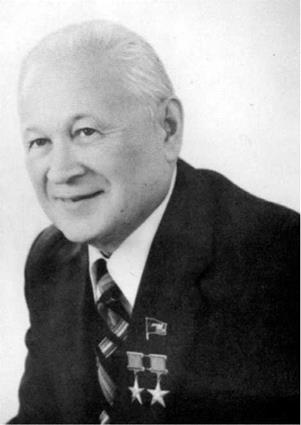REVISING THE SOYUZ COMPLEX
In early 1964, Russia’s plans were still to fly around the moon using the Soyuz complex. With the construction of Soyuz already under way, the R-7 rocket already available and the first group flights showing remarkable promise, there was a real prospect that this could be achieved over 1966-7 or so.
There was still considerable uncertainty about the future medium – and long-term direction of the Soviet space effort. The death of John Kennedy had now eliminated the prospect of a joint mission. In 1963, Jodrell Bank Observatory director Bernard Lovell had visited the Soviet Union as a guest of Mstislav Keldysh and learned, to his surprise, that the Soviet Union had no plans to race the Americans to the moon (exactly as Khrushchev had told the United Nations). Instead, they would build an Earth-orbiting space platform. Indeed, designs of Soviet cosmonauts spacewalking around such platforms soon found their way to the West. Bernard Lovell’s remarks were disputed by some Soviet scientists, but his visit created some considerable doubt about the nature of Soviet intentions.
Although the Soyuz complex had made considerable progress during 1962-3, this slowed down during 1964. However, it is important to stress that the Soyuz complex was no mere study. Not only did the design progress to an advanced stage, but initial flight models were in construction. The slowdown was not because of an action on the part of government, but due to gross overwork in OKB-1. Concerned with the complexities of the Earth orbit rendezvous manoeuvres required, Korolev now began to revise the concept. The weight of the complex to be assembled in Earth orbit would be about the same, 18 tonnes. Under the new plan:
• Only three spacecraft would be involved.
• The rocket block would use the much more powerful hydrogen fuel.
• The Soyuz spacecraft would, for the lunar journey, be shortened and lightened to five tonnes: the orbital module would not be carried. This would now be called the Soyuz 7K-L-1 (L for Luna, Luniy or moon).
Learning about this, a rival design bureau, OKB-52 of Vladimir Chelomei, came up with a rival proposal. Using the new Proton rocket which he was building, he said that he could send such a spacecraft directly to the moon. Only one rocket would be required and there was no need for orbital rendezvous or the transfer of fuels in Earth orbit. He persuaded the government that the plans for Earth orbital rendezvous were too cumbersome. Korolev was so busy with other projects and Chelomei managed to get government approval before he realized what was going on and could stop him.
The arrival of a competitor to Korolev was an important development. Until 1964, Korolev had, as chief designer, ruled supreme over the Soviet space programme. Vladimir Chelomei was a slightly younger man than Korolev – he was born in 1914 – and when Korolev had developed the German V-2 after the war, Chelomei had built derivatives of the V-1 flying bomb. Prom 1944 to 1954, Chelomei had developed pulse jet engines, cruise missiles and sea-borne rockets. His style was quite different from Korolev, being smartly dressed, with a polished manner and he was a great communicator. All who met him paid tribute to his ambition and powers of persuasion. Chelomei was a professor of the Baumann Technical School, a member of the Academy of Sciences from 1958 and full academician from 1962. He was able to offer the Kremlin a viable military space programme: new military rockets (SS-9, Tsyklon, Proton), anti-satellite weapons (Polyot), radar observation satellites and was even working on a manned platform for space surveillance (Almaz). Nikita Khrushchev’s son Sergei worked for him.
Chelomei was not the only challenger to Korolev’s hitherto undisputed prominence. Korolev’s former collaborator, Valentin Glushko, ran a large engine design bureau, OKB-456, and as we saw in 1958 the two had already quarrelled over the upper stage for the R-7 used to fire the first cosmic ship. In Dnepropetrovsk, Ukraine, another large design bureau had grown up under Mikhail Yangel. He built military missiles for the Soviet rocket troops by the hundreds in his sprawling factory there.
|
Vladimir Chelomei |
Some of the missiles were adapted as satellite launchers and by 1962 his design bureau was building small military satellites.











